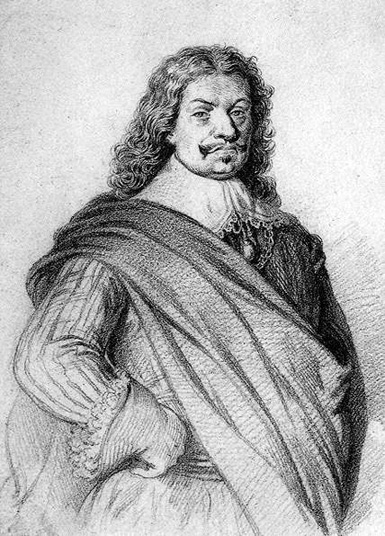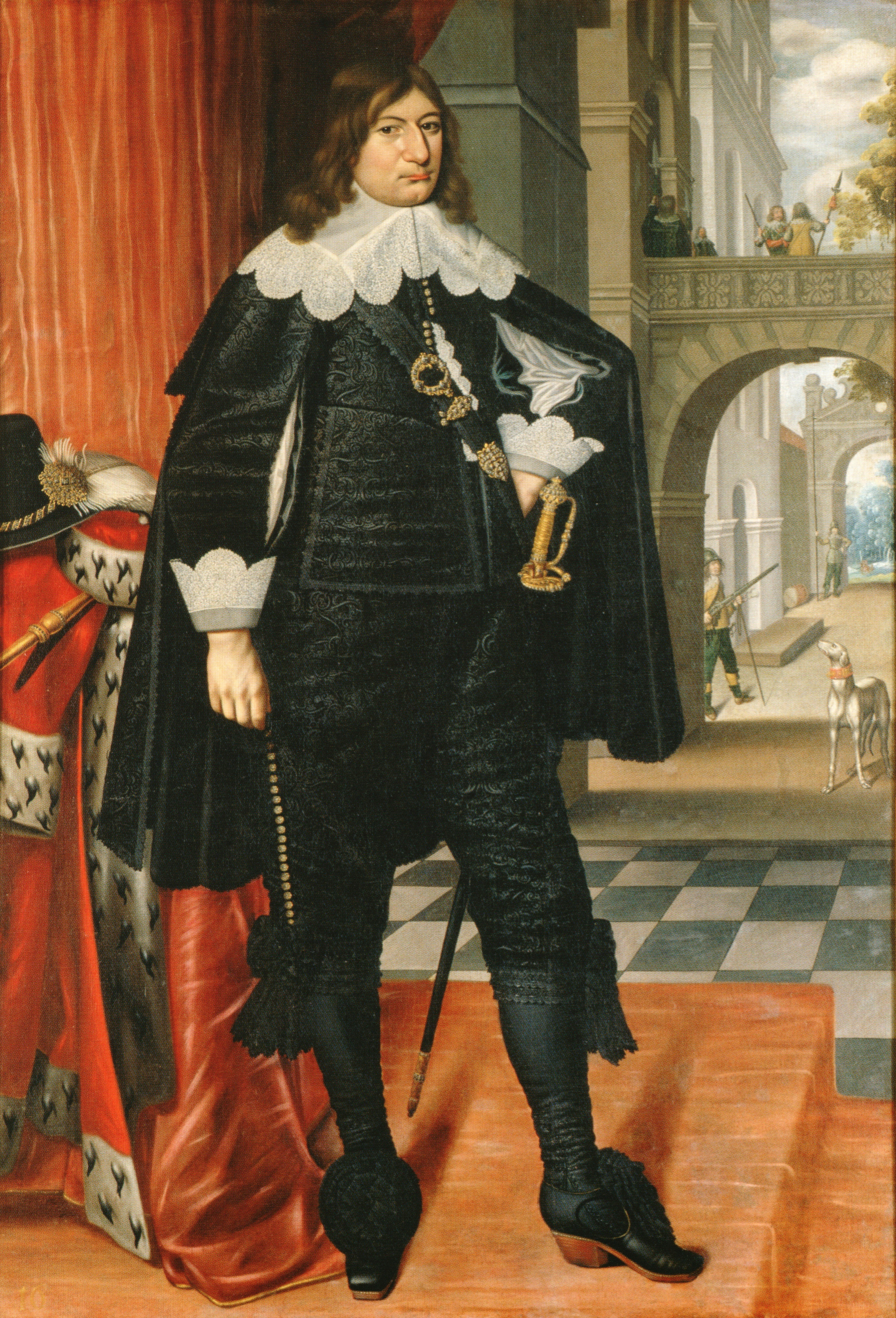|
Montecuccoli's Landing On Funen
Montecuccoli's landing on Funen occurred on 26 June 1659 when an allied force, six Dutch ships and 9,000 troops attempted to land on Swedish-occupied Funen. The Dutch ships initially bombarded the Swedish positions and the Allied troops managed to land unopposed. These were later repulsed by the 4,000 Swedish troops under the command of Carl Gustaf Wrangel. The allies suffered heavy casualties with 5 of the Dutch warships being damaged. Background After the capture of Fredriksodde in 1659, all of Jutland was under the control of the anti-Swedish coalition. However, they would not stay for long as their goal was to go to Copenhagen, and they assembled a force of 9,000 men at Stenderup in southern Jutland to land on Funen. Before doing so, they captured the island of Fanö to defend their flank. Landing On 26 June, the allies shipped over their troops under the command of Raimondo Montecuccoli on around 60 boats, which were defended by six Dutch warships. After bombarding what ... [...More Info...] [...Related Items...] OR: [Wikipedia] [Google] [Baidu] |
Funen
Funen (, ), is the third-largest List of islands of Denmark, island of Denmark, after Zealand and North Jutlandic Island, Vendsyssel-Thy, with an area of . It is the List of islands by area, 165th-largest island in the world. It is located in the central part of the country and has a population of 469,947 as of 2020. Funen's main city is Odense, which is connected to the sea by a seldom-used canal. The city's shipyard, Odense Steel Shipyard, has been relocated outside Odense proper. Funen belongs administratively to the Region of Southern Denmark. From 1970 to 2006 the island formed the biggest part of Funen County, which also included the islands of Langeland, Ærø, Tåsinge, and a number of smaller islands. Funen is linked to Zealand, Denmark's largest island, by the Great Belt Bridge, which carries both trains and cars. The bridge is in reality three bridges; low road and rail bridges connect Funen to the small island of Sprogø in the middle of the Great Belt, and a long ro ... [...More Info...] [...Related Items...] OR: [Wikipedia] [Google] [Baidu] |
Middelfart
Middelfart is a town in central Denmark, with a population of 16,749 . The town is the municipal seat of Middelfart Municipality on the island of Funen (). Etymology The name Middelfart, first recorded as "Mæthælfar" in Valdemar's Census Book in 1231, consists of the old Danish word ''mæthal'' meaning 'middle' and ''far'' meaning 'way'. This name originally referred to the strait ''Snævringen'' ('the narrowing'), which is the narrowest part of the Little Belt, and was subsequently applied to the settlement as well. History It is not known when the town was established but it certainly owes its existence to its location at the narrowest point across the Little Belt. The town was granted its first privileges at the end of the 13th century at a time when fishing played an important role in addition to its ferry link to Snoghøj in Jutland. From the Middle Ages the town appears to have specialized in catching harbour porpoises. In the 16th century cattle export was also significa ... [...More Info...] [...Related Items...] OR: [Wikipedia] [Google] [Baidu] |
Battles Involving The Dutch Republic
A battle is an occurrence of combat in warfare between opposing military units of any number or size. A war usually consists of multiple battles. In general, a battle is a military engagement that is well defined in duration, area, and force commitment. An engagement with only limited commitment between the forces and without decisive results is sometimes called a skirmish. The word "battle" can also be used infrequently to refer to an entire operational campaign, although this usage greatly diverges from its conventional or customary meaning. Generally, the word "battle" is used for such campaigns if referring to a protracted combat encounter in which either one or both of the combatants had the same methods, resources, and strategic objectives throughout the encounter. Some prominent examples of this would be the Battle of the Atlantic, Battle of Britain, and the Battle of France, all in World War II. Wars and military campaigns are guided by military strategy, whereas batt ... [...More Info...] [...Related Items...] OR: [Wikipedia] [Google] [Baidu] |
Battle Of Ebeltoft
The Battle of Ebeltoft was a naval battle between a Swedish and a Danish/Dutch fleet, during the Dano-Swedish War of 1658 to 1660. The allied fleet was ordered to secure a troop transport fleet to the Swedish-controlled island Fyn. Eight Swedish frigates under the command of Owen Coxe attacked the fleet and took the allies by surprise. After a long fight one Dutch ship exploded, the rest of the Danish/Dutch ships were captured and the transport fleet was destroyed. The Danish captain was badly wounded and died during the battle. After the battle, Owen Coxe was ennobled under the name Siölöw. Sources Martin Pavón: Søslaget i Ebeltoft Vig "1001 fortællinger om Danmark" *↑ "Søværnets mærkedage - Juli". Flådens historie. 2008-05-30. Hentet 2011-12-07. *Ulf Sundberg, Hjalmarson and Högberg (1998). Svenska krig 1521-1814 * Ebeltoft Ebeltoft 1659 in Europe Ebeltoft Ebeltoft is an old port town on the central east coast of Denmark with a population of 7,287 (1 Januar ... [...More Info...] [...Related Items...] OR: [Wikipedia] [Google] [Baidu] |
Ebeltoft
Ebeltoft is an old port town on the central east coast of Denmark with a population of 7,287 (1 January 2025).BY3: Population 1. January by urban areas, area and population density The Mobile Statbank from Statistics Denmark It is located in Syddjurs municipality in Region Midtjylland on the larger Djursland peninsula of Jutland. Ebeltoft is known for its old town center with cobble-stoned streets and centuries-old half-timbered houses. Plans for the conservation of this peculiar environment, was initiated in the 1960s by the city council and the National Museum of Denmark. Apart from this overall old-village charm, Ebeltoft holds several other notable institutions such as Glasmuseet Ebeltoft, one of the world's first glass museums, Jylland (ship), Fregatten Jylland, the longest wooden ... [...More Info...] [...Related Items...] OR: [Wikipedia] [Google] [Baidu] |
Frederick William, Elector Of Brandenburg
Frederick William (; 16 February 1620 – 29 April 1688) was Elector of Brandenburg and Duke of Prussia, thus ruler of Brandenburg-Prussia, from 1640 until his death in 1688. A member of the House of Hohenzollern, he is popularly known as "the Great Elector" (') because of his military and political achievements. Frederick William was a staunch pillar of the Calvinist faith, associated with the rising commercial class. He saw the importance of trade and promoted it vigorously. His shrewd domestic reforms gave Prussia a strong position in the post-Westphalian political order of Northern-Central Europe, setting up Prussia for elevation from duchy to kingdom, achieved under his son and successor. Biography Elector Frederick William was born in Berlin to George William, Elector of Brandenburg, and Elisabeth Charlotte of the Palatinate. His inheritance consisted of the Margraviate of Brandenburg, the Duchy of Cleves, the County of Mark, and the Duchy of Prussia. Owing to th ... [...More Info...] [...Related Items...] OR: [Wikipedia] [Google] [Baidu] |
Dano-Swedish War (1658–1660)
The Dano-Swedish War of 1658–1660 was a war between Denmark–Norway and Sweden, with the former backed by the Dutch Republic and Poland. It is known in Denmark as the Second Karl Gustav War (), in Norway as Bjelkes Feud () in Sweden as Karl Gustav's Second Danish War (), and in the Netherlands as the Swedish-Dutch War (). It was a continuation of an earlier conflict between the two belligerents which had ended just months earlier, after Sweden and Denmark brokered a peace agreement in Roskilde in 1658. In the aftermath of that conflict, the Swedish king Charles X Gustav desired to add the province of Royal Prussia in Poland to the Swedish realm, but his position in the region was not strong enough with the opposition of Brandenburg and Austria.Frost, p. 180. However, the Danes stalled and prolonged the fulfillment of some provisions of the earlier peace; the Swedish king decided to use this as a pretext to attack with an ambitious goal: to vanquish Denmark as a sovereign sta ... [...More Info...] [...Related Items...] OR: [Wikipedia] [Google] [Baidu] |
Stenderup
Sundeved (German language, German: ''Sundewitt'') is a peninsula on the east coast of the Jutland peninsula in south Denmark. It lies between Åbenrå Fjord and Als Fjord to the north, Alssund to the east and Flensborg Fjord to the south. The westernmost part of the city of Sønderborg is located on the peninsula, while most of the city lies on the neighboring island of Als Island, Als. Geography History Sundeved Municipality Until 2007, Sundeved () was also the name of a municipality in the former South Jutland County. The municipality covered an area of 69 km2, and had a total population of 5,298 (2005). Its last mayor was John Solkær Pedersen. Towns in the municipality included Avnbøl, Ballebro, Blans, Stenderup, Ullerup, Vester Sottrup, and Øster Sottrup. The municipality was created in 1970 as the result a ("Municipality Reform") that merged a number of existing parishes: Nybøl Parish, Sottrup Parish, and Ullerup Parish. Sundeved municipality ceased to exist ... [...More Info...] [...Related Items...] OR: [Wikipedia] [Google] [Baidu] |
Copenhagen
Copenhagen ( ) is the capital and most populous city of Denmark, with a population of 1.4 million in the Urban area of Copenhagen, urban area. The city is situated on the islands of Zealand and Amager, separated from Malmö, Sweden, by the Øresund strait. The Øresund Bridge connects the two cities by rail and road. Originally a Vikings, Viking fishing village established in the 10th century in the vicinity of what is now Gammel Strand, Copenhagen became the capital of Denmark in the early 15th century. During the 16th century, the city served as the ''de facto'' capital of the Kalmar Union and the seat of the Union's monarchy, which governed most of the modern-day Nordic countries, Nordic region as part of a Danish confederation with Sweden and Norway. The city flourished as the cultural and economic centre of Scandinavia during the Renaissance. By the 17th century, it had become a regional centre of power, serving as the heart of the Danish government and Military history ... [...More Info...] [...Related Items...] OR: [Wikipedia] [Google] [Baidu] |






